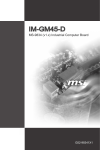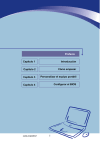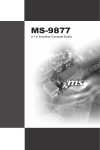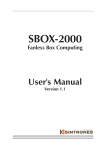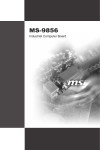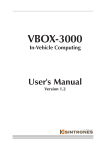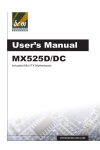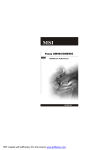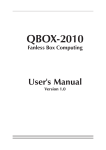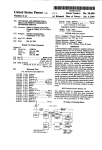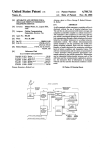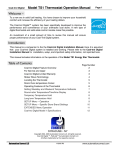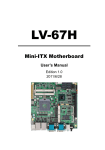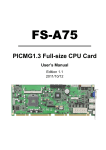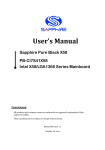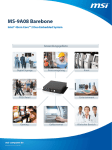Download MS-9A08 - Verybox
Transcript
MS-9A08 Industrial Computer System G52-9A081X1 ▍ PREFACE Copyright Notice The material in this document is the intellectual property of MICRO-STAR INTERNATIONAL. We take every care in the preparation of this document, but no guarantee is given as to the correctness of its contents. Our products are under continual improvement and we reserve the right to make changes without notice. Trademarks All trademarks are the properties of their respective owners. ■ ■ ■ ■ ■ ■ ■ ■ ■ ■ ■ ■ MSI® is registered trademark of Micro-Star Int’l Co.,Ltd. NVIDIA® is registered trademark of NVIDIA Corporation. ATI® is registered trademark of ATI Technologies, Inc. AMD® is registered trademarks of AMD Corporation. Intel® is registered trademarks of Intel Corporation. Windows® is registered trademarks of Microsoft Corporation. AMI® is registered trademark of Advanced Micro Devices, Inc. Award® is a registered trademark of Phoenix Technologies Ltd. Sound Blaster® is registered trademark of Creative Technology Ltd. Realtek® is registered trademark of Realtek Semiconductor Corporation. JMicron® is registered trademark of JMicron Technology Corporation. Netware® is a registered trademark of Novell, Inc. Revision History Revision Revision History Date V1.0 First release July 2009 Technical Support If a problem arises with your system and no solution can be obtained from the user’s manual, please contact your place of purchase or local distributor. Alternatively, please try the following help resources for further guidance. ◙ ◙ Visit the MSI website for FAQ, technical guide, BIOS updates, driver updates, and other information: http://www.msi.com/index. php?func=service Contact our technical staff at: http://ocss.msi.com ii MS-9A08 Safety Instructions ■ ■ ■ ■ ■ ■ ■ ■ ■ ■ ■ Always read the safety instructions carefully. Keep this User’s Manual for future reference. Keep this equipment away from humidity. Lay this equipment on a reliable flat surface before setting it up. The openings on the enclosure are for air convection hence protects the equipment from overheating. DO NOT COVER THE OPENINGS. Make sure the voltage of the power source and adjust properly 110/220V before connecting the equipment to the power inlet. Place the power cord such a way that people can not step on it. Do not place anything over the power cord. Always Unplug the Power Cord before inserting any add-on card or module. All cautions and warnings on the equipment should be noted. Never pour any liquid into the opening that could damage or cause electrical shock. If any of the following situations arises, get the equipment checked by service personnel: ◯ ◯ ◯ ◯ The power cord or plug is damaged. ◯ ◯ The equipment has dropped and damaged. Liquid has penetrated into the equipment. The equipment has been exposed to moisture. The equipment does not work well or you can not get it work according to User’s Manual. The equipment has obvious sign of breakage. DO NOT LEAVE THIS EQUIPMENT IN AN ENVIRONMENT UNCONDITIONED, STORAGE TEMPERATURE ABOVE 60oC (140oF), IT MAY DAMAGE THE EQUIPMENT. CAUTION: Danger of explosion if battery is incorrectly replaced. Replace only with the same or equivalent type recommended by the manufacturer. 警告使用者: 這是甲類資訊產品,在居住的環境中使用時,可能會造成無線電干擾,在這種情況下, 使用者會被要求採取某些適當的對策。 廢電池請回收 For better environmental protection, waste batteries should be collected separately for recycleing special disposal. iii ▍ PREFACE FCC-B Radio Frequency Interference Statement This equipment has been tested and found to comply with the limits for a Class B digital device, pursuant to Part 15 of the FCC Rules. These limits are designed to provide reasonable protection against harmful interference in a residential installation. This equipment generates, uses and can radiate radio frequency energy and, if not installed and used in accordance with the instructions, may cause harmful interference to radio communications. However, there is no guarantee that interference will not occur in a particular installation. If this equipment does cause harmful interference to radio or television reception, which can be determined by turning the equipment off and on, the user is encouraged to try to correct the interference by one or more of the measures listed below. ◯ Reorient or relocate the receiving antenna. ◯ Increase the separation between the equipment and receiver. ◯ Connect the equipment into an outlet on a circuit different from that to which the receiver is connected. ◯ Consult the dealer or an experienced radio/television technician for help. Notice 1 The changes or modifications not expressly approved by the party responsible for compliance could void the user’s authority to operate the equipment. Notice 2 Shielded interface cables and A.C. power cord, if any, must be used in order to comply with the emission limits. Micro-Star International MS-9A08 OIR LA NOTICE D’INSTALLATION AVANT DE RACCORDER AU RESEAU. This device complies with Part 15 of the FCC Rules. Operation is subject to the following two conditions: 1) this device may not cause harmful interference, and 2) this device must accept any interference received, including interference that may cause undesired operation. iv MS-9A08 WEEE (Waste Electrical and Electronic Equipment) Statement ENGLISH To protect the global environment and as an environmentalist, MSI must remind you that... Under the European Union (“EU”) Directive on Waste Electrical and Electronic Equipment, Directive 2002/96/EC, which takes effect on August 13, 2005, products of “electrical and electronic equipment” cannot be discarded as municipal waste anymore and manufacturers of covered electronic equipment will be obligated to take back such products at the end of their useful life. MSI will comply with the product take back requirements at the end of life of MSI-branded products that are sold into the EU. You can return these products to local collection points. DEUTSCH Hinweis von MSI zur Erhaltung und Schutz unserer Umwelt Gemäß der Richtlinie 2002/96/EG über Elektro- und Elektronik-Altgeräte dürfen Elektro- und Elektronik-Altgeräte nicht mehr als kommunale Abfälle entsorgt werden. MSI hat europaweit verschiedene Sammel- und Recyclingunternehmen beauftragt, die in die Europäische Union in Verkehr gebrachten Produkte, am Ende seines Lebenszyklus zurückzunehmen. Bitte entsorgen Sie dieses Produkt zum gegebenen Zeitpunkt ausschliesslich an einer lokalen Altgerätesammelstelle in Ihrer Nähe. FRANÇAIS En tant qu’écologiste et afin de protéger l’environnement, MSI tient à rappeler ceci... Au sujet de la directive européenne (EU) relative aux déchets des équipement électriques et électroniques, directive 2002/96/EC, prenant effet le 13 août 2005, que les produits électriques et électroniques ne peuvent être déposés dans les décharges ou tout simplement mis à la poubelle. Les fabricants de ces équipements seront obligés de récupérer certains produits en fin de vie. MSI prendra en compte cette exigence relative au retour des produits en fin de vie au sein de la communauté européenne. Par conséquent vous pouvez retourner localement ces matériels dans les points de collecte. РУССКИЙ Компания MSI предпринимает активные действия по защите окружающей среды, поэтому напоминаем вам, что.... В соответствии с директивой Европейского Союза (ЕС) по предотвращению загрязнения окружающей среды использованным электрическим и электронным оборудованием (директива WEEE 2002/96/EC), вступающей в силу 13 августа 2005 года, изделия, относящиеся к электрическому и электронному оборудованию, не могут рассматриваться как бытовой мусор, поэтому производители вышеперечисленного электронного оборудования обязаны принимать его для переработки по окончании срока службы. MSI обязуется соблюдать требования по приему продукции, проданной под маркой MSI на территории EC, в переработку по окончании срока службы. Вы можете вернуть эти изделия в специализированные пункты приема. ▍ PREFACE ESPAÑOL MSI como empresa comprometida con la protección del medio ambiente, recomienda: Bajo la directiva 2002/96/EC de la Unión Europea en materia de desechos y/o equipos electrónicos, con fecha de rigor desde el 13 de agosto de 2005, los productos clasificados como “eléctricos y equipos electrónicos” no pueden ser depositados en los contenedores habituales de su municipio, los fabricantes de equipos electrónicos, están obligados a hacerse cargo de dichos productos al termino de su período de vida. MSI estará comprometido con los términos de recogida de sus productos vendidos en la Unión Europea al final de su periodo de vida. Usted debe depositar estos productos en el punto limpio establecido por el ayuntamiento de su localidad o entregar a una empresa autorizada para la recogida de estos residuos. NEDERLANDS Om het milieu te beschermen, wil MSI u eraan herinneren dat…. De richtlijn van de Europese Unie (EU) met betrekking tot Vervuiling van Electrische en Electronische producten (2002/96/EC), die op 13 Augustus 2005 in zal gaan kunnen niet meer beschouwd worden als vervuiling. Fabrikanten van dit soort producten worden verplicht om producten retour te nemen aan het eind van hun levenscyclus. MSI zal overeenkomstig de richtlijn handelen voor de producten die de merknaam MSI dragen en verkocht zijn in de EU. Deze goederen kunnen geretourneerd worden op lokale inzamelingspunten. SRPSKI Da bi zaštitili prirodnu sredinu, i kao preduzeće koje vodi računa o okolini i prirodnoj sredini, MSI mora da vas podesti da… Po Direktivi Evropske unije (“EU”) o odbačenoj ekektronskoj i električnoj opremi, Direktiva 2002/96/EC, koja stupa na snagu od 13. Avgusta 2005, proizvodi koji spadaju pod “elektronsku i električnu opremu” ne mogu više biti odbačeni kao običan otpad i proizvođači ove opreme biće prinuđeni da uzmu natrag ove proizvode na kraju njihovog uobičajenog veka trajanja. MSI će poštovati zahtev o preuzimanju ovakvih proizvoda kojima je istekao vek trajanja, koji imaju MSI oznaku i koji su prodati u EU. Ove proizvode možete vratiti na lokalnim mestima za prikupljanje. POLSKI Aby chronić nasze środowisko naturalne oraz jako firma dbająca o ekologię, MSI przypomina, że... Zgodnie z Dyrektywą Unii Europejskiej (“UE”) dotyczącą odpadów produktów elektrycznych i elektronicznych (Dyrektywa 2002/96/EC), która wchodzi w życie 13 sierpnia 2005, tzw. “produkty oraz wyposażenie elektryczne i elektroniczne “ nie mogą być traktowane jako śmieci komunalne, tak więc producenci tych produktów będą zobowiązani do odbierania ich w momencie gdy produkt jest wycofywany z użycia. MSI wypełni wymagania UE, przyjmując produkty (sprzedawane na terenie Unii Europejskiej) wycofywane z użycia. Produkty MSI będzie można zwracać w wyznaczonych punktach zbiorczych. vi MS-9A08 TÜRKÇE Çevreci özelliğiyle bilinen MSI dünyada çevreyi korumak için hatırlatır: Avrupa Birliği (AB) Kararnamesi Elektrik ve Elektronik Malzeme Atığı, 2002/96/EC Kararnamesi altında 13 Ağustos 2005 tarihinden itibaren geçerli olmak üzere, elektrikli ve elektronik malzemeler diğer atıklar gibi çöpe atılamayacak ve bu elektonik cihazların üreticileri, cihazların kullanım süreleri bittikten sonra ürünleri geri toplamakla yükümlü olacaktır. Avrupa Birliği’ne satılan MSI markalı ürünlerin kullanım süreleri bittiğinde MSI ürünlerin geri alınması isteği ile işbirliği içerisinde olacaktır. Ürünlerinizi yerel toplama noktalarına bırakabilirsiniz. ČESKY Záleží nám na ochraně životního prostředí - společnost MSI upozorňuje... Podle směrnice Evropské unie (“EU”) o likvidaci elektrických a elektronických výrobků 2002/96/EC platné od 13. srpna 2005 je zakázáno likvidovat “elektrické a elektronické výrobky” v běžném komunálním odpadu a výrobci elektronických výrobků, na které se tato směrnice vztahuje, budou povinni odebírat takové výrobky zpět po skončení jejich životnosti. Společnost MSI splní požadavky na odebírání výrobků značky MSI, prodávaných v zemích EU, po skončení jejich životnosti. Tyto výrobky můžete odevzdat v místních sběrnách. MAGYAR Annak érdekében, hogy környezetünket megvédjük, illetve környezetvédőként fellépve az MSI emlékezteti Önt, hogy ... Az Európai Unió („EU”) 2005. augusztus 13-án hatályba lépő, az elektromos és elektronikus berendezések hulladékairól szóló 2002/96/EK irányelve szerint az elektromos és elektronikus berendezések többé nem kezelhetőek lakossági hulladékként, és az ilyen elektronikus berendezések gyártói kötelessé válnak az ilyen termékek visszavételére azok hasznos élettartama végén. Az MSI betartja a termékvisszavétellel kapcsolatos követelményeket az MSI márkanév alatt az EU-n belül értékesített termékek esetében, azok élettartamának végén. Az ilyen termékeket a legközelebbi gyűjtőhelyre viheti. ITALIANO Per proteggere l’ambiente, MSI, da sempre amica della natura, ti ricorda che…. In base alla Direttiva dell’Unione Europea (EU) sullo Smaltimento dei Materiali Elettrici ed Elettronici, Direttiva 2002/96/EC in vigore dal 13 Agosto 2005, prodotti appartenenti alla categoria dei Materiali Elettrici ed Elettronici non possono più essere eliminati come rifiuti municipali: i produttori di detti materiali saranno obbligati a ritirare ogni prodotto alla fine del suo ciclo di vita. MSI si adeguerà a tale Direttiva ritirando tutti i prodotti marchiati MSI che sono stati venduti all’interno dell’Unione Europea alla fine del loro ciclo di vita. È possibile portare i prodotti nel più vicino punto di raccolta vii ▍ PREFACE ▍ Table of Contents Copyright Notice�����������������������������������������������������������������������������������������������������ii Trademarks������������������������������������������������������������������������������������������������������������ii Revision History�����������������������������������������������������������������������������������������������������ii Technical Support��������������������������������������������������������������������������������������������������ii Safety Instructions�������������������������������������������������������������������������������������������������iii FCC-B Radio Frequency Interference Statement�������������������������������������������������iv WEEE (Waste Electrical and Electronic Equipment) Statement����������������������������v Chapter 1 Overview�������������������������������������������������������������������������������������������� 1-1 Packing Checklist��������������������������������������������������������������������������������������� 1-2 System Overview��������������������������������������������������������������������������������������� 1-3 System Specifications�������������������������������������������������������������������������������� 1-6 Mainboard Layout�������������������������������������������������������������������������������������� 1-8 Chapter 2 System Assembly������������������������������������������������������������������������������ 2-1 Installation Tools���������������������������������������������������������������������������������������� 2-2 Removing the Chassis Cover�������������������������������������������������������������������� 2-3 Installing the CPU & Heat Pipe������������������������������������������������������������������ 2-4 Installing Memory��������������������������������������������������������������������������������������� 2-6 Installing the Wireless LAN Card��������������������������������������������������������������� 2-7 Installing the Hard Disk Drive��������������������������������������������������������������������� 2-9 Replacing the Chassis Cover������������������������������������������������������������������� 2-11 Connecting the VESA Mount������������������������������������������������������������������� 2-12 Chapter 3 Mainboard Setup������������������������������������������������������������������������������� 3-1 Quick Components Guide�������������������������������������������������������������������������� 3-2 CPU (Central Processing Unit)������������������������������������������������������������������ 3-3 Memory������������������������������������������������������������������������������������������������������ 3-4 Power Supply��������������������������������������������������������������������������������������������� 3-5 Rear Panel I/O������������������������������������������������������������������������������������������� 3-6 Connectors������������������������������������������������������������������������������������������������� 3-8 Jumpers��������������������������������������������������������������������������������������������������� 3-15 Slot����������������������������������������������������������������������������������������������������������� 3-16 viii MS-9A08 Chapter 4 BIOS Setup������������������������������������������������������������������������������������ 4-1 Entering Setup��������������������������������������������������������������������������������������� 4-2 The Menu Bar���������������������������������������������������������������������������������������� 4-4 Main������������������������������������������������������������������������������������������������������� 4-5 Advanced����������������������������������������������������������������������������������������������� 4-6 Boot������������������������������������������������������������������������������������������������������ 4-17 Security������������������������������������������������������������������������������������������������ 4-20 Chipset������������������������������������������������������������������������������������������������� 4-21 Exit������������������������������������������������������������������������������������������������������� 4-24 ix Chapter 1 Overview Thank you for choosing the MS-9A08 v1.X, an excellent industrial computer system from MSI. Based on the innovative Intel® GM45 & ICH9EM chipsets for optimal system efficiency, the MS-9A08 accommodates the latest 45nm Intel® Penryn/Core 2 Duo/Celeron M processors in Socket P and supports up to 2 DDR2 667/800 SO-DIMM slots to provide the maximum of 4GB memory capacity. In the advanced-level and mid-range market segment, the MS-9A08 provides a high-performance solution for applications on digital signage, kiosk, gaming, and thin client. ▍ OVERVIEW Packing Checklist Power Adapter MS-9A08 System Power Cord Heat Pipe VESA Mount Kit 1-2 HDD Screw Set User’s Manual Driver/Utility Disk MS-9A08 System Overview External View Internal View 1-3 ▍ OVERVIEW CPU Socket SO-DIMM Slots Mini PCI-E Slot SATA Ports 32-bit PCI Slot Front View Rear View 1-4 MS-9A08 Serial Ports (Optional) The serial port is a 16550A high speed communications port that sends/ receives 16 bytes FIFOs. You can attach a serial mouse or other serial devices directly to the connector. USB Ports The USB (Universal Serial Bus) port is for attaching USB devices such as keyboard, mouse, or other USB-compatible devices. Power Button Power Input (DC 19V) HDMI Port The High-Definition Multimedia Interface (HDMI) is an all-digital audio/video interface capable of transmitting uncompressed streams. HDMI supports all TV format, including standard, enhanced, or highdefinition video, plus multi-channel digital audio on a single cable. DVI Port The DVI (Digital Visual Interface) connector allows you to connect an LCD monitor. It provides a high-speed digital interconnection between the computer and its display device. To connect an LCD monitor, simply plug your monitor cable into the DVI connector, and make sure that the other end of the cable is properly connected to your monitor (refer to your monitor manual for more information.) Gigabit LAN Jacks The standard RJ-45 LAN jack is for connection to the Local Area Network (LAN). You can connect a network cable to it. Audio Jacks These audio connectors are used for audio devices. You can differentiate the color of the audio jacks for different audio sound effects. ■ Line-In (Blue) - Line In, is used for external CD player, tapeplayer or other audio devices. ■ Line-Out (Green) - Line Out, is a connector for speakers or headphones. ■ Mic (Pink) - Mic, is a connector for microphones. Ventilation Hole 1-5 ▍ OVERVIEW System Specifications Processor ■ 45nm Intel Penryn/Core 2 Duo/Celeron M processors in Socket P FSB ■ 667/ 800/ 1066MHz Chipset ■ North Bridge: Intel GM45 chipset ■ South Bridge: Intel ICH9EM chipset Memory ■ 2 DDR2 667/800 SO-DIMM slots (200 pins / 1.8V) ■ Supports the maximum of 4GB LAN ■ Gigabit Fast Ethernet by Intel 82574L & 82567 GbE controller SATA ■ 4 SATAII ports by Intel ICH9EM ■ Storage and data transfers at up to 3Gb/s Audio ■ HDA Codec by Realtek ALC888 7.1 channel ■ Compliant with Azalia 1.0 specs ■ 6 watt amplifier Connectors ■ Front Panel I/O - 3 serial ports (optional) - 2 USB ports - 1 power button ■ Rear Panel I/O - 1 serial port - 1 HDMI port - 1 DVI port - 2 Gigabit LAN jacks - 4 USB ports - 3 audio jacks 1-6 MS-9A08 ■ Onboard Connectors/Pinheaders - 1 front panel audio pinheader - 1 USB 2.0 pinheader (2 ports) - 4 RS-232 serial port connectors - 1 SPI Flash ROM pinheader (for debugging) - 1 S/PDIF-out pinheader - 1 LVDS connector - 1 amplifier pinheader Slot ■ 1 Mini PCI-E slot ■ 1 32-bit/33MHz PCI slot Chassis Dimension ■ 180mm x 180mm x 44mm (L x W x H) Regulatory Compliance ■ FCC Class B, CE, C-Tick, BSMI, VCCI, RoHS compliance Environmental ■ Operating Temperature: 0oC to 40oC ■ Storage Temperature: -20oC to 80oC 1-7 ▍ OVERVIEW Mainboard Layout MS-9834 v1.X Mainboard 1-8 Chapter 2 System Assembly This chapter provides you with the information on system assembly procedures. While doing the installation, be careful in holding the components and follow the installation procedures. For some components, if you install in the wrong orientation, the components will not work properly. Use a grounded wrist strap before handling computer components. Static electricity may damage the components. Important Only For Service Personnel Always unplug the power cord before inserting any add-on card or module. ▍ system assembly Installation Tools A Phillips (crosshead) screwdriver and a flathead screwdriver, can be used to do most of the installation. Choose one with a magnetic head would be better. Pliers, can be used as an auxiliary tool to connect some connectors or cables. Forceps, can be used to pick up tiny screws or set up the jumpers. Rubber gloves, can prevent yourself from being incised and suffering the static charge. 2-2 MS-9A08 Removing the Chassis Cover Step 1: Locate and remove the screws (two on each side as indicated by red circles) that secure the cover to the chassis. Step 2: Lift the cover up gently. Step 3: The system fan has been preinstalled in the system. Disconnect the fan power connector and put the chassis cover aside for later use. 2-3 ▍ system assembly Installing the CPU & Heat Pipe Step 1: Locate the CPU socket on the mainboard. Important On the upper end of the CPU socket is a socket actuator in the form of a slotted screw head. Make sure that you open or close the socket with a flathead screwdriver before and after installing the CPU. Step 2: Turn the socket actuator counterclockwise to open the socket. Locate the golden arrow on the CPU and align it to the upper right corner of the socket. Put the CPU gently down. If the socket is completely opened, the CPU pins will securely fit into the socket. Step 3: Turn the socket actuator clockwise to close the socket. 2-4 MS-9A08 Step 4: Apply some thermal paste on the CPU for better heat dispersion before placing the heat pipe onto it. Step 5: Align the screw holes and tighten the 4 screws in diagonal order until each is firmly tightened. Step 6: Fasten the 2 screws on the rear panel to secure the heat sink in place. 2-5 ▍ system assembly Installing Memory Step 1: Locate the DIMM1 SO-DIMM slot. Align the notch on the DIMM with the key on the slot and insert the DIMM into the slot at 45-degree angle. Step 2: Push the DIMM gently forwards until the slot levers click and lock the DIMM in place. Follow the same procedures to install the second DIMM if necessary. Step 3: To uninstall the DIMM, flip the slot levers outwards and the DIMM will be released instantly. Important • You can barely see the golden finger if the DIMM is properly inserted in the DIMM slot. • To enable successful system boot-up, always insert the DIMM into the DIMM1 first. 2-6 MS-9A08 Installing the Wireless LAN Card Step 1: Break open the antenna hole on the rear panel. Step 2: Insert the antenna connector into the hole and tighten it with a hex nut. Step 3: Connect the external WLAN antenna. 2-7 ▍ system assembly Step 4: Locate the mini PCI-E slot and remove the LAN card screw preinstalled on the mainboard. Step 5: Insert the wireless LAN card into the mini PCI-E slot at 45-degree angle. Step 6: Push the card gently down and fasten it with screws. Step 7: Connect the antenna cable to the wireless LAN card. 2-8 MS-9A08 Installing the Hard Disk Drive Step 1: Put the rubber pads to the screw holds of the HDD bracket. Step 2: Insert the HDD into the bracket with screw holes aligned. Step 3: Tighten the four screws to fix the HDD to the bracket. Important Please make sure the HDD is properly and completely fixed to the bracket. 2-9 ▍ system assembly Step 4 Connect the SATA signal & power cable to the HDD. Step 5: Locate the SATA ports and the HDD power connector on the mainboard. Step 6: Step 7: Connect the SATA signal cable to the SATA port. Connect the SATA power cable to the HDD power connector. 2-10 MS-9A08 Replacing the Chassis Cover Step 1: Connect the fan power connector. Step 2: Place the chassis cover back to the chassis. Step 3: Fasten the screws (2 on each side) to secure the cover. 2-11 ▍ system assembly Connecting the VESA Mount Step 1: Open the VESA mount package and check the components. Four screws and two VESA mount plates are included. Screw type: plat, cross recess, #6, 5.2mm, 4.5mm, machine screw, NYLOK, plated zinc VESA mount hole pattern: 100mm x 200mm Step 2: Fasten the VESA mount plates to the chassis with the supplied screws. 2-12 MS-9A08 Important X VESA Mount Plate O VESA Mount Plate When mounting the MS-9A08, make sure that you align the VESA mount plates to the left and right of the targeted monitor, instead of top and bottom. Damage caused by improper installation will void the warranty. VESA Mount Plate VESA Mount Plate 2-13 Chapter 3 Mainboard Setup This chapter provides you with the information on mainboard hardware configurations. Incorrect setting of jumpers and connectors may damage your mainboard. Please pay special attention not to connect these headers in wrong direction. DO NOT adjust any jumper while the mainboard is powered on. ▍ mainboard setup Quick Components Guide JFP1, p.3-10 COM5, COM3, COM2, p.3-14 JUSB2, p.3-13 JSPD1, p.3-10 PCI1, p.3-16 JAUD1, p.3-11 JAMP1, p.3-11 J4, p3-5 SATA1~4, p.3-9 COM4, p.3-14 CON1, p.3-16 JCASE1, p.3-9 JLVDS1, p.3-12 JSPI1, p.3-14 CPU, p.3-3 SYSFAN1, p.3-8 CPUFAN1, p.3-8 JPW1, p.3-5 DIMM Slots, p.3-4 J2, p.3-15 3-2 J1, p.3-15 Back Panel I/O, p.3-6 MS-9A08 CPU (Central Processing Unit) When you are installing the CPU, make sure that you install the cooler to prevent overheating. If you do not have the CPU cooler, consult your dealer before turning on the computer. Important Overheating Overheating will seriously damage the CPU and system. Always make sure the cooling fan can work properly to protect the CPU from overheating. Make sure that you apply an even layer of thermal paste (or thermal tape) between the CPU and the heatsink to enhance heat dissipation. Replacing the CPU While replacing the CPU, always turn off the power supply or unplug the power supply’s power cord from the grounded outlet first to ensure the safety of CPU. 3-3 ▍ mainboard setup Memory These DIMM slots are intended for memory modules. DDR2 SO-DIMM Slot 200-pin, 1.8V Installing Memory Modules 1. Locate the DIMM1 SO-DIMM slot. Align the notch on the DIMM with the key on the slot and insert the DIMM into the slot at 45-degree angle. 2. Push the DIMM gently forwards until the slot levers click and lock the DIMM in place. Follow the same procedures to install the second DIMM if necessary. 3. To uninstall the DIMM, flip the slot levers outwards and the DIMM will be released instantly. Important • You can barely see the golden finger if the DIMM is properly inserted in the DIMM slot. • To enable successful system boot-up, always insert the DIMM into the DIMM1 first. 3-4 MS-9A08 Power Supply System Power Connector: JPW1 This connector provides power to the system and CPU. JPW1 Pin Definition JPW1 1 2 3 4 PIN SIGNAL 1 2 3 4 GND GND 12V 12V SATA HDD Power Connector: J4 This connector provides power to the SATA hard disk drive. J4 +12V GND GND VCC5 Important Power supply of 200watts (and above) is highly recommended for system stability. 3-5 ▍ mainboard setup Rear Panel I/O Line-In LAN LAN Line-Out Serial Port HDMI Port DVI Port USB Port USB Port Mic-In ▶ Serial Port The serial port is a 16550A high speed communications port that sends/ receives 16 bytes FIFOs. You can attach a serial mouse or other serial devices directly to the connector. ▶ HDMI Port The High-Definition Multimedia Interface (HDMI) is an all-digital audio/video interface capable of transmitting uncompressed streams. HDMI supports all TV format, including standard, enhanced, or high-definition video, plus multi-channel digital audio on a single cable. ▶ DVI Port The DVI-D (Digital Visual Interface-Digital) connector allows you to connect an LCD monitor. It provides a high-speed digital interconnection between the computer and its display device. To connect an LCD monitor, simply plug your monitor cable into the DVI connector, and make sure that the other end of the cable is properly connected to your monitor (refer to your monitor manual for more information.) ▶ USB Port The USB (Universal Serial Bus) port is for attaching USB devices such as keyboard, mouse, or other USB-compatible devices. 3-6 MS-9A08 ▶ LAN The standard RJ-45 LAN jack is for connection to the Local Area Network (LAN). You can connect a network cable to it. Activity Indicator LED Color 10M Cable Plug-in 100M Cable Plug-in 1000M Cable Plug-in Speed Indicator Left LED Right LED Active LED 100M/1000M Speed LED Yellow Green/Orange No Transmission OFF OFF Transition Yellow (Blinking) OFF No Transmission OFF Green (Lighting) Transition Yellow (Blinking) Green (Lighting) No Transmission OFF Orange (Lighting) Transition Yellow (Blinking) Orange (Lighting) Green (Lighting) OFF In S3/S4/S5 Standby State ▶ Audio Ports ■ ■ ■ Line-In (Blue) - Line In, is used for external CD player, tapeplayer or other audio devices. Line-Out (Green) - Line Out, is a connector for speakers or headphones. Mic (Pink) - Mic, is a connector for microphones. 3-7 ▍ mainboard setup Connectors Fan Power Connector: CPUFAN1, SYSFAN1 The fan power connectors support system cooling fan with +12V. When connecting the wire to the connectors, always note that the red wire is the positive and should be connected to the +12V; the black wire is Ground and should be connected to GND. If the mainboard has a System Hardware Monitor chipset onboard, you must use a specially designed fan with speed sensor to take advantage of the CPU fan control. CONTROL SENSOR +12V GND CPUFAN1 SENSOR +12V GND SYSFAN1 Important • Please refer to the recommended CPU fans at processor’s official website or consult the vendors for proper CPU cooling fan. • Fan cooler set with 3- or 4-pin power connector are both available for CPUFAN1. 3-8 MS-9A08 Chassis Intrusion Connector: JCASE1 This connector is provided to connect the chassis intrusion switch cable. If the chassis is opened, the chassis intrusion mechanism will be activated. The system will record this status and show a warning message on the screen. To clear the warning, you must enter the BIOS utility and clear the record. JCASE1 GND CINTRU Serial ATA II Connector: SATA1 ~ SATA4 This connector is a high-speed Serial ATA II interface port. Each connector can connect to one Serial ATA II device. SATA2 SATA4 SATA1 SATA3 Important Please do not fold the Serial ATA cable into 90-degree angle. Otherwise, data loss may occur during transmission. 3-9 ▍ mainboard setup S/PDIF-Out Connector: JSPD1 (Optional) This connector is used to connect S/PDIF (Sony & Philips Digital Interconnect Format) interface for digital audio transmission. JSPD1 GND S/PDIF-Out 5V 3 1 S/PDIF Bracket (Optional) Front Panel Connector: JFP1 The mainboard provides one front panel connector for electrical connection to the front panel switches and LEDs. The JFP1 is compliant with Intel® Front Panel I/O Connectivity Design Guide. Power Power LED Switch + - JFP1 2 1 10 9 + - - + HDD Reset LED Switch 3-10 PIN SIGNAL DESCRIPTION 1 2 3 4 5 6 7 8 9 10 HD_LED + FP PWR/SLP HD_LED FP PWR/SLP RST_SW PWR_SW + RST_SW + PWR_SW RSVD_DNU KEY Hard disk LED pull-up MSG LED pull-up Hard disk active LED MSG LED pull-up Reset Switch low reference pull-down to GND Power Switch high reference pull-up Reset Switch high reference pull-up Power Switch low reference pull-down to GND Reserved. Do not use. Key MS-9A08 Audio Amplifier Connector: JAMP1 The JAMP1 is used to connect audio amplifiers to enhance audio performance. JAMP1 1 PIN SIGNAL 1 2 3 4 AMP_LAMP_L+ AMP_RAMP_R+ Front Panel Audio Connector: JAUD1 This connector allows you to connect the front panel audio and is compliant with Intel® Front Panel I/O Connectivity Design Guide. JAUD1 9 10 1 2 PIN SIGNAL DESCRIPTION 1 2 3 4 MIC_L GND MIC_R PRESENCE# Microphone - Left channel Ground Microphone - Right channel Active low signal-signals BIOS that a High Definition Audio dongle is connected to the analog header. PRESENCE# = 0 when a High Definition Audio dongle is connected 5 6 7 LINE out_R MIC_JD Front_JD Analog Port - Right channel Jack detection return from front panel microphone JACK1 Jack detection sense line from the High Definition Audio CODEC jack detection resistor network 8 9 10 NC LINE out_L LINEout_JD No connection Analog Port - Left channel Jack detection return from front panel JACK2 3-11 ▍ mainboard setup LVDS Flat Panel Connector: JLVDS1 The LVDS (Low Voltage Differential Signal) connector provides a digital interface typically used with flat panels. After connecting an LVDS interfaced flat panel to the JLVDS1, be sure to check the panel datasheet and set the J2 jumper (p. 3-15) for proper power voltage. Display Matrix JLVDS1 CRT CRT 2 1 40 39 SIGNAL +12V +12V GND GND LCD_VDD LDDC_DATA LVDS_VDDEM GND LA_DATA0 LA_DATA1 LA_DATA2 LA_CLK LA_DATA3 GND LB_DATA0 LB_DATA1 LB_DATA2 LB_CLK LB_DATA3 GND 3-12 DVI HDMI V V V V V LVDS V DVI V V HDMI V V PIN 2 4 6 8 10 12 14 16 18 20 22 24 26 28 30 32 34 36 38 40 LVDS SIGNAL 1 3 5 7 9 11 13 15 17 19 21 23 25 27 29 31 33 35 37 39 +12V +12V +12V VCC3/VCC5 LCD_VDD LDDC_CLK L_BKLTCTL L_BKLTEM LA_DATA0# LA_DATA1# LA_DATA2# LA_CLK# LA_DATA3# GND LB_DATA0# LB_DATA1# LB_DATA2# LB_CLK# LB_DATA3# GND V V MS-9A08 Front USB Connector: JUSB2 This connector, compliant with Intel® I/O Connectivity Design Guide, is ideal for connecting high-speed USB interface peripherals such as USB HDD, digital cameras, MP3 players, printers, modems and the like. JUSB2 2 1 10 9 PIN SIGNAL PIN SIGNAL 1 3 5 7 9 VCC USB6USB6+ GND KEY 2 4 6 8 10 VCC USB7USB7+ GND NC USB 2.0 Bracket (Optional) Important Important Note that the pins of VCC and GND must be connected correctly to avoid possible damage. 3-13 ▍ mainboard setup RS-232 Serial Port Connector: COM2 ~ COM5 This connector is a 16550A high speed communications port that sends/receives 16 bytes FIFOs. You can attach a serial device to it through the optional serial port bracket. COM2/3/4/5 2 1 10 9 PIN SIGNAL DESCRIPTION 1 2 3 4 5 6 7 8 9 10 DCD SIN SOUT DTR GND DSR RTS CTS RI KEY Data Carry Detect Serial In or Receive Data Serial Out or Transmit Data Data Terminal Ready Ground Data Set Ready Request To Send Clear To Send Ring Indicate Key SPI Flash ROM Connector: JSPI1 This connector is used to flash SPI flash ROM. JSPI1 9 10 3-14 1 2 PIN SIGNAL PIN SIGNAL 1 3 5 7 9 VCC3_SB SPI_MISO_F SPI_CS0_F# GND SPI_HOLD# 2 4 6 8 10 VCC3_SB SPI_MOSI_F SPI_CLK_F GND NC MS-9A08 Jumpers Serial Port Power Jumper: J1 This jumper specifies the operation voltage of the onboard serial ports. J1 1 1 1 +12V +5V LVDS Power Jumper: J2 Use this jumper to specify the LVDS power. J2 1 1 1 +3V +5V 3-15 ▍ mainboard setup Slot PCI (Peripheral Component Interconnect) Express Slot The PCI Express slot supports the PCI Express interface expansion card. The CON1 is Mini PCI-E connector for wireless LAN, TV tuner, and Robson NAND Flash. Mini PCI-E Slot PCI (Peripheral Component Interconnect) Slot The PCI slot supports LAN card, SCSI card, USB card, and other add-on cards that comply with PCI specifications. 32-bit PCI Slot Important When adding or removing expansion cards, make sure that you unplug the power supply first. Meanwhile, read the documentation for the expansion card to configure any necessary hardware or software settings for the expansion card, such as jumpers, switches or BIOS configuration. 3-16 Chapter 4 BIOS Setup This chapter provides information on the BIOS Setup program and allows you to configure the system for optimum use. You may need to run the Setup program when: ■ An error message appears on the screen during the system booting up, and requests you to run SETUP. ■ You want to change the default settings for customized features. ▍ BIOS SETUP Entering Setup Power on the computer and the system will start POST (Power On Self Test) process. When the message below appears on the screen, press <DEL> key to enter Setup. Press DEL to enter SETUP If the message disappears before you respond and you still wish to enter Setup, restart the system by turning it OFF and On or pressing the RESET button. You may also restart the system by simultaneously pressing <Ctrl>, <Alt>, and <Delete> keys. Important • The items under each BIOS category described in this chapter are under continuous update for better system performance. Therefore, the description may be slightly different from the latest BIOS and should be held for reference only. • Upon boot-up, the 1st line appearing after the memory count is the BIOS version. It is usually in the format: A9834IMS V1.0 051509 where: 1st digit refers to BIOS maker as A = AMI, W = AWARD, and P = PHOENIX. 2nd - 5th digit refers to the model number. 6th digit refers to the chipset as I = Intel, N = NVIDIA, A = AMD and V = VIA. 7th - 8th digit refers to the customer as MS = all standard customers. V1.0 refers to the BIOS version. 051509 refers to the date this BIOS was released. 4-2 MS-9A08 Control Keys <↑> Move to the previous item <↓> Move to the next item <←> Move to the item in the left hand <→> Move to the item in the right hand <Enter> Select the item <Esc> Jumps to the Exit menu or returns to the main menu from a submenu <+/PU> Increase the numeric value or make changes <-/PD> Decrease the numeric value or make changes <F1> General Help <F9> Load Optimized Defaults <F8> Load Fail-Safe Defaults <F10> Save all the CMOS changes and exit Getting Help After entering the Setup menu, the first menu you will see is the Main Menu. Main Menu The main menu lists the setup functions you can make changes to. You can use the arrow keys ( ↑↓ ) to select the item. The on-line description of the highlighted setup function is displayed at the bottom of the screen. Sub-Menu If you find a right pointer symbol (as shown in the right view) appears to the left of certain fields that means a sub-menu can be launched from this field. A sub-menu contains additional options for a field parameter. You can use arrow keys ( ↑↓ ) to highlight the field and press <Enter> to call up the sub-menu. Then you can use the control keys to enter values and move from field to field within a sub-menu. If you want to return to the main menu, just press the <Esc >. General Help <F1> The BIOS setup program provides a General Help screen. You can call up this screen from any menu by simply pressing <F1>. The Help screen lists the appropriate keys to use and the possible selections for the highlighted item. Press <Esc> to exit the Help screen. 4-3 ▍ BIOS SETUP The Menu Bar ▶ Main Use this menu for basic system configurations, such as time, date etc. ▶ Advanced Use this menu to setup the items of special enhanced features. ▶ Boot Use this menu to specify the priority of boot devices. ▶ Security Use this menu to set supervisor and user passwords. ▶ Chipset This menu controls the advanced features of the onboard Northbridge and Southbridge. ▶ Exit This menu allows you to load the BIOS default values or factory default settings into the BIOS and exit the BIOS setup utility with or without changes. 4-4 MS-9A08 Main ▶ AMI BIOS, Processor, System Memory These items show the firmware and hardware specifications of your system. Read only. ▶ System Time This setting allows you to set the system time. The time format is <Hour> <Minute> <Second>. ▶ System Date This setting allows you to set the system date. The date format is <Day>, <Month> <Date> <Year>. 4-5 ▍ BIOS SETUP Advanced ▶ CPU Configuration 4-6 MS-9A08 ▶ Hardware Prefetcher The processor has a hardware prefetcher that automatically analyzes its requirements and prefetches data and instructions from the memory into the Level 2 cache that are likely to be required in the near future. This reduces the latency associated with memory reads. When enabled, the processor’s hardware prefetcher will be enabled and allowed to automatically prefetch data and code for the processor. When disabled, the processor’s hardware prefetcher will be disabled. ▶ Adjacent Cache Line Prefetch The processor has a hardware adjacent cache line prefetch mechanism that automatically fetches an extra 64-byte cache line whenever the processor requests for a 64-byte cache line. This reduces cache latency by making the next cache line immediately available if the processor requires it as well. When enabled, the processor will retrieve the currently requested cache line, as well as the subsequent cache line. When disabled, the processor will only retrieve the currently requested cache line. ▶ Max CPUID Value Limit The Max CPUID Value Limit BIOS feature allows you to circumvent problems with older operating systems that do not support the Intel Pentium 4 processor with Hyper-Threading Technology. When enabled, the processor will limit the maximum CPUID input value to 03h when queried, even if the processor supports a higher CPUID input value. When disabled, the processor will return the actual maximum CPUID input value of the processor when queried. ▶ Intel(R) Virtualization Tech Virtualization enhanced by Intel Virtualization Technology will allow a platform to run multiple operating systems and applications in independent partitions. With virtualization, one computer system can function as multiple irtual?systems. ▶ TM2 Function This setting enables/disables the TM2 (Thermal Monitor 2) function. ▶ Execute Disable Bit Capability Intel’s Execute Disable Bit functionality can prevent certain classes of malicious “buffer overflow” attacks when combined with a supporting operating system. This functionality allows the processor to classify areas in memory by where application code can execute and where it cannot. When a malicious worm attempts to insert code in the buffer, the processor disables code execution, preventing damage or worm propagation. 4-7 ▍ BIOS SETUP ▶ Core Multi-Processing CMP (Core Multi Processing) is the ability to have many independent processing cores on a single die, each with their own L1 Code & Data caches, Local APICs & thermal controls, while having a shared L2 cache, power management & bus interface. Intel multi-core architecture has a single Intel processor package that contains two or more processor “execution cores,” or computational engines to enable enhanced performance and more-efficient simultaneous processing of multiple tasks. ▶ Intel(R) SpeedStep(tm) Tech EIST (Enhanced Intel SpeedStep Technology) allows the system to dynamically adjust processor voltage and core frequency, which can result in decreased average power consumption and decreased average heat production. ▶ IDE Configuration ▶ SATA#1 Configuration This setting specifies the operation mode of SATA ports. ▶ Configure SATA#1 as This setting specifies the function of the on-chip SATA controller. 4-8 MS-9A08 ▶ Primary/Secondary/Third/Fourth IDE Master [Type] Press PgUp/<+> or PgDn/<-> to select [Manual], [None] or [Auto] type. Note that the specifications of your drive must match with the drive table. The hard disk will not work properly if you enter improper information for this category. If your hard disk drive type is not matched or listed, you can use [Manual] to define your own drive type manually. [LBA/Large Mode] Enabling LBA causes Logical Block Addressing to be used in place of Cylinders, Heads and Sectors [Block(MultiSector Transfer)] Any selection except Disabled determines the number of sectors transferred per block [PIO Mode] Indicates the type of PIO (Programmed Input/Output) [DMA Mode] Indicates the type of Ultra DMA [S.M.A.R.T.] This allows you to activate the S.M.A.R.T. (SelfMonitoring Analysis & Reporting Technology) capability for the hard disks. S.M.A.R.T is a utility that monitors your disk status to predict hard disk failure. This gives you an opportunity to move data from a hard disk that is going to fail to a safe place before the hard disk becomes offline. [32 Bit Data Transfer] Enables 32-bit communication between CPU and IDE controller 4-9 ▍ BIOS SETUP ▶ Hardware Health Configuration These items display the current status of all monitored hardware devices/components such as voltages, temperatures and all fans’ speeds. ▶ H/W Health Function This setting enables/disables the hardware monitor function. ▶ Chassis Intrusion The field enables or disables the feature of recording the chassis intrusion status and issuing a warning message if the chassis is once opened. To clear the warning message, set the field to [Reset]. The setting of the field will automatically return to the default value later. ▶ CPUFAN0 Mode Setting, AUXFAN Mode Setting This item enables or disables the Smart Fan feature. Smart Fan is an excellent feature which will adjust the CPU/system fan speed automatically depending on the current CPU temperature to prevent your system from overheating. ▶ CPUFAN0 PWM Control, AUXFAN PWM Control This setting allows users to control the fan speed by changing the duty cycle of the fan PWM (Pulse-Width Modulation) output. 4-10 MS-9A08 ▶ ACPI Configuration ▶ Suspend Mode This item specifies the power saving modes for ACPI function. If your operating system supports ACPI, you can choose to enter the Standby mode in S1 (POS) or S3 (STR) fashion through the setting of this field. ▶ USB Device Wakeup From S3 This setting allows the activity of the USB device to wake up the system from the S3 sleep state. 4-11 ▍ BIOS SETUP ▶ APM Configuration ▶ Restore on AC Power Loss This setting specifies whether your system will reboot after a power failure or interrupt occurs. Available settings are: [Power Off] Leaves the computer in the power off state. [Power On] Leaves the computer in the power on state. [Last State] Restores the system to the previous status before power failure or interrupt occurred. ▶ Resume On Ring An input signal on the serial Ring Indicator (RI) line (in other words, an incoming call on the modem) awakens the system from a soft off state. ▶ Resume On LAN This field specifies whether the system will be awakened from power saving modes when activity or input signal of onboard LAN is detected. ▶ Resume On RTC Alarm When [Enabled], your can set the date and time at which the RTC (real-time clock) alarm awakens the system from suspend mode. 4-12 MS-9A08 ▶ Super IO Configuration ▶ Serial Port 1/2/3/4/5 Address, Serial Port 1/2/3/4/5 IRQ Select an address and a corresponding interrupt for the specified serial ports. ▶ Watch Dog You can enable the system watch-dog timer, a hardware timer that generates either an NMI or a reset when the software that it monitors does not respond as expected each time the watch dog polls it. 4-13 ▍ BIOS SETUP ▶ MPS Configuration ▶ MPS Revision This field allows you to select which MPS (Multi-Processor Specification) version to be used for the operating system. You need to select the MPS version supported by your operating system. To find out which version to use, consult the vendor of your operating system. ▶ USB Configuration 4-14 MS-9A08 ▶ Legacy USB Support Set to [Enabled] if you need to use any USB 1.1/2.0 device in the operating system that does not support or have any USB 1.1/2.0 driver installed, such as DOS and SCO Unix. ▶ USB 2.0 Controller Mode This setting specifies the operation mode of the onboard USB 2.0 controller. ▶ BIOS EHCI Hand-Off This setting allows you to enable or disable a workaround for operating systems without EHCI (Enhanced Host Controller Interface) hand-off support. The Enhanced Host Controller Interface (EHCI) specification describes the register-level interface for a Host Controller for the Universal Serial Bus (USB) Revision 2.0. ▶ USB Mass Storage Device Configuration ▶ USB Mass Storage Reset Delay This setting controls the number of seconds the POST waits for the USB mass storage device after the start unit command is sent. ▶ Emulation Type This setting enables you to set the type of device you want the USB mass storage device to emulate. 4-15 ▍ BIOS SETUP ▶ Trusted Computing ▶ TCG/TPM Support This setting controls the Trusted Platform Module (TPM) designed by the Trusted Computing Group (TCG). TPMs are special-purpose integrated circuits (ICs) built into a variety of platforms to enable strong user authentication and machine attestation -- ssential to prevent inappropriate access to confidential and sensitive information and to protect against compromised networks. ▶ Execute TPM Command TPM commands are managed through a child node of the TPM Management console named Command Management. To block or allow a TPM command is a task that local administrators can perform during the setup or re-configuration of a TPM-equipped computer. ▶ TPM Enable/Disable Status This setting displays the TPM enable/disable status. Read only. ▶ TPM Owner Status This setting shows the TPM ownership. Read only. 4-16 MS-9A08 Boot ▶ Boot Settings Configuration ▶ Quick Boot Enabling this setting will cause the BIOS power-on self test routine to skip some of its tests during bootup for faster system boot. 4-17 ▍ BIOS SETUP ▶ Quiet Boot This BIOS feature determines if the BIOS should hide the normal POST messages with the motherboard or system manufacturer’s full-screen logo. When it is enabled, the BIOS will display the full-screen logo during the boot-up sequence, hiding normal POST messages. When it is disabled, the BIOS will display the normal POST messages, instead of the full-screen logo. Please note that enabling this BIOS feature often adds 2-3 seconds of delay to the booting sequence. This delay ensures that the logo is displayed for a sufficient amount of time. Therefore, it is recommended that you disable this BIOS feature for a faster boot-up time. ▶ Bootup Num-Lock This setting is to set the Num Lock status when the system is powered on. Setting to [On] will turn on the Num Lock key when the system is powered on. Setting to [Off] will allow users to use the arrow keys on the numeric keypad. ▶ Wait For “F1” If Error When this setting is set to [Enabled] and the boot sequence encounters an error, it asks you to press F1. If disabled, the system continues to boot without waiting for you to press any keys. ▶ Hit “DEL” Message Display Set this option to [Disabled] to prevent the message as follows: Hit Del if you want to run setup It will prevent the message from appearing on the first BIOS screen when the computer boots. Set it to [Enabled] when you want to run the BIOS Setup Utility. ▶ Flash Write Protection This function protects the BIOS from accidental corruption by unauthorized users or computer viruses. When enabled, the BIOS data cannot be changed when attempting to update the BIOS with a Flash utility. To successfully update the BIOS, you will need to disable this Flash Protection function. 4-18 MS-9A08 ▶ Boot Device Priority The items allow you to set the sequence of boot devices where BIOS attempts to load the disk operating system. First press <Enter> to enter the sub-menu. Then you may use the arrow keys ( ↑↓ ) to select the desired device, then press <+>, <-> or <PageUp>, <PageDown> key to move it up/down in the priority list. ▶ Removable Drives This setting allows users to set the priority of the removable devices. First press <Enter> to enter the sub-menu. Then you may use the arrow keys ( ↑↓ ) to select the desired device, then press <+>, <-> or <PageUp>, <PageDown> key to move it up/down in the priority list. 4-19 ▍ BIOS SETUP Security ▶ Supervisor Password / Change Supervisor Password Supervisor Password controls access to the BIOS Setup utility. These settings allow you to set or change the supervisor password. ▶ User Password / Change User Password User Password controls access to the system at boot. These settings allow you to set or change the user password. 4-20 MS-9A08 Chipset ▶ North Bridge Configuration ▶ DVMT Mode Select Intel’s Dynamic Video Memory Technology (DVMT) allows the system to dy4-21 ▍ BIOS SETUP namically allocate memory resources according to the demands of the system at any point in time. The key idea in DVMT is to improve the efficiency of the memory allocated to either system or graphics processor. It is recommended that you set this BIOS feature to DVMT Mode for maximum performance. Setting it to DVMT Mode ensures that system memory is dynamically allocated for optimal balance between graphics and system performance. ▶ DVMT/FIXED Memory When set to DVMT/FIXED Mode, the graphics driver will allocate a fixed amount of memory as dedicated graphics memory, as well as allow more system memory to be dynamically allocated between the graphics processor and the operating system. ▶ Boot Display Device Use the field to select the type of device you want to use as the display(s) of the system. ▶ Flat Panel Type This setting allows you to set your preferences for the boot display device. ▶ South Bridge Configuration ▶ USB Functions, USB Port Configure These settings specify the function of the onboard USB controller. ▶ USB 2.0 Controller Set to [Enabled] if you need to use any USB 2.0 device in the operating system that does not support or have any USB 2.0 driver installed, such as DOS and SCO Unix. 4-22 MS-9A08 ▶ GbE Controller This setting disables/enables the onboard Gigabit Ethernet controller. ▶ GbE LAN Boot When [Enabled], the BIOS attempts to boot from a LAN boot image before it attempts to boot from a local storage device. ▶ GbE Wake Up From S5 This field specifies whether the system will be awakened from the S5 power saving mode when activity or input signal of onboard LAN is detected. ▶ HDA Controller This setting controls the High Definition Audio interface integrated in the Southbridge. ▶ SMBUS Controller This setting controls the system management bus controller integrated in the Southbridge. ▶ LAN (82574) Option ROM The item enables/disables the initialization of the onboard LAN Boot ROM during bootup. Selecting [Disabled] will speed up the boot process. 4-23 ▍ BIOS SETUP Exit ▶ Save Changes and Exit Save changes to CMOS and exit the Setup Utility. ▶ Discard Changes and Exit Abandon all changes and exit the Setup Utility. ▶ Discard Changes Abandon all changes and continue with the Setup Utility. ▶ Load Optimal Defaults Use this menu to load the default values set by the mainboard manufacturer specifically for optimal performance of the mainboard. ▶ Load Failsafe Defaults Use this menu to load the default values set by the BIOS vendor for stable system performance. 4-24








































































